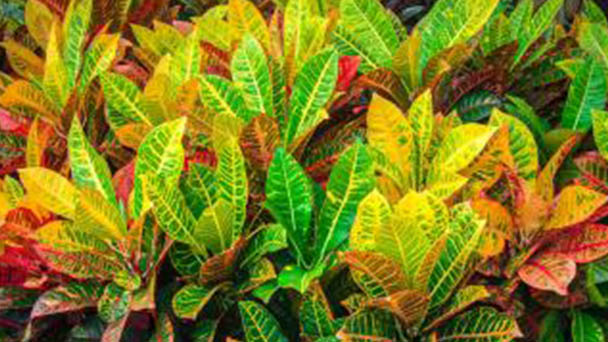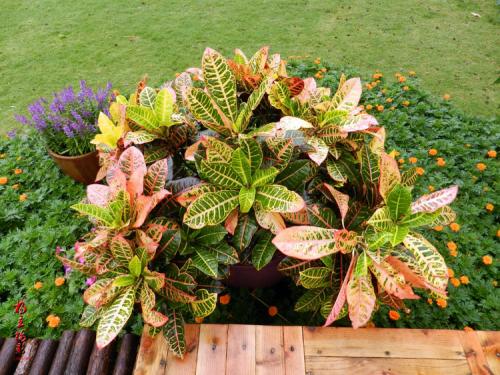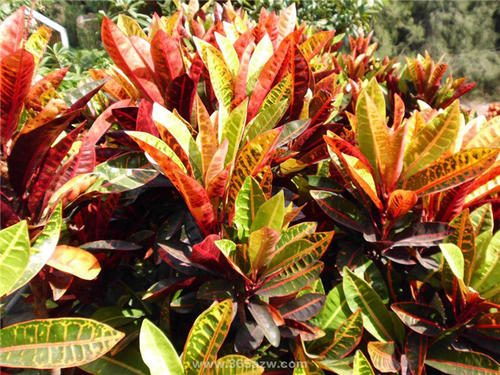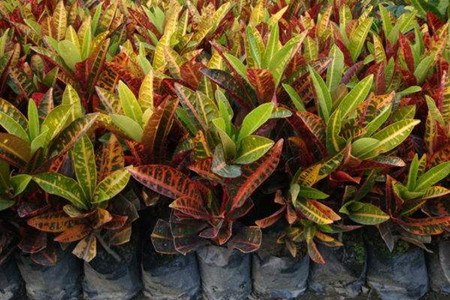Croton (Codiaeum variegatum) profile
Written by Maggie
Mar 15 2021

Croton is a shrub or small tree up to 2 m tall. Croton branches are glabrous, there are obvious leaf marks. Leaves are thin leathery, shape and size vary greatly, linear, linear lanceolate, oblong, elliptic, lanceolate, ovate, spatulate, viola to obovate, sometimes by the long midvein leaves into two pieces.5-30 cm long, (0.3-) 0.5-8 cm wide.
Croton picture

Croton info
| Botanical Name | Codiaeum variegatum |
| Common Names | Croton |
| Plant Type | Evergreen shrub |
| Sun | Bright, indirect light |
| Hardiness Zones | 11, 12 |
| Flower color | n/a |
| Native Area | Tropical Asia and Pacific regions |
| Mature size | Varies by variety |
Morphological characteristics of Croton
Branch
Croton is a shrub or small tree, up to 2 m tall.Branches glabrous, there are obvious leaf marks.
Leaf
The leaves of Croton are thin leathery and vary greatly in shape and size, including linear, linear lanceolate, oblong, elliptic, lanceolate, ovate, spatulate, viola to obovate. Sometimes the leaves are separated into two pieces by a long midvein.5-30 cm long, (0.3-) 0.5-8 cm wide, apex mucronate, acuminate to obtuse, base cuneate, mucronate to obtuse, margin entire, lobed to lobed, both surfaces glabrous, green, light green, purplish red, purplish red and yellow, yellow and green or sometimes scattered yellow or golden spots or markings on green leaves; Petiole of Croton is 0.2-2.5 cm long.
Flowers
Croton is racemose, axillary, dioecious, 8-30 cm long, male flowers: white, sepals 5; Croton has 5 petals, much smaller than sepals; Croton has 5 glands; Stamens 20-30; Pedicels are slender; Female flowers: pale yellow, sepals ovate-triangular; Disk is annular; Ovary is 3-loculed, flowers curved, undivided; Pedicels are slightly thick. Capsule is subglobose, slightly oblate, glabrous, ca. 9 mm in diam. Seeds are about 6 mm long.
The ecological habits of Croton
Croton likes high temperature, humid and sunny environments, and is not cold resistant. Soil with fertile, strong water - retaining clay loam soil is appropriate. Potting is a mixture of culture soil, leaf rot soil and coarse sand.
The optimum temperature for Croton growth is 20 ~ 30℃, 21 ~ 30℃. The temperature in winter is not lower than 13℃. Short-term at 10℃, the leaf color is not bright, dim, or lacking luster. When the temperature was 4 ~ 5℃, the leaves were damaged by freezing, resulting in a large number of fallen leaves, and even the whole plant was frozen to death.
Croton likes wet and hates dry. Stems and leaves grow rapidly during the growing period, give plenty of water, and spray water to the foliage every day. But in winter when low temperature basin soil to keep slightly dry.If the semi-dormant state in winter, too much water will cause falling leaves, which must be strictly controlled.
Croton is a photophilic plant, which needs sufficient sunshine throughout the growing period. Its stems and leaves grow luxuriantly, and its leaves are bright in color, especially with red markings. 50 thousand ~ 80 thousand lux is most suitable. If illumination is insufficient for a long time, leaf markings, spots are not obvious, lack of luster, soft branches, and even produce fallen leaves.
How to grow and care for Croton
Watering
Croton like water wet, from spring to summer growing season to water, often to the leaf spray, keep the leaf clean and wet environment.
Fertilizer
Growing period of general monthly application of 1 times liquid fertilizer or slow - release fertilizer.
Soil
Croton is pleasant to be fertile, sticky heavy and water retention good soil, cultivation soil can be used sticky soil, leaf rot soil, rotten manure and so on deployment.
The temperature
Croton is a tropical plant, the growth temperature is 20-35℃, winter should not be lower than 15℃. If the temperature drops below 10℃, the leaves will fall off. When the temperature rises in the next spring, the frozen branches can be cut off and the growth can be resumed by strengthening management.
Light
Croton likes full of sunshine, not tolerant of shade. Indoor should be placed in the sunny south window and ventilated place, so as not to fall off the lower blade.
Potting and Repotting
Repot a croton in spring when needed. Use a container only one size larger than the plant's current container. Put 1 to 2 inches of damp peat-based potting soil into the new container. Turn the croton on its side and gently slide it out of its container. Set it in the new pot and fill in around the roots with potting soil. Water the plant and add additional soil if needed to bring the soil level to about 1 inch below the rim
Croton's propagation
Seed propagation
Seed selection
Before sowing, we must first select the seeds. The seeds of Croton are well chosen, which is directly related to the success of sowing.
It is best to choose the seeds of the harvest. The longer the seed is kept, the lower its germination rate will be.
The selection of full seeds, no incomplete or deformed seeds.
3. Choose seeds that are free of pests and diseases.
Disinfection
Disinfection consists of two concepts, one refers to the disinfection of the seed, and the other refers to the disinfection of the substrate used for sowing. The family is commonly used to seed disinfection 60℃ or so of hot water immersed in a quarter of an hour, and then reoccupy lukewarm water sprouts 12 ~ 24 hours. The best way to disinfect the substrate used for sowing is to put it in a wok and heat it up, which will kill any insects and diseases.
Sprouting
Soak the seeds of Croton in warm water (about the same temperature as your face wash) for 12 to 24 hours, until the seeds absorb water and swell. For very common seeds that germinate easily, this job can be left out.
Sow
For by hand or other tools hard to clamp the tiny seeds, we can put the toothpick wet with water, at the end of the stick a grain by a grain of the seeds on the surface of the substrate, the substrate 1 cm thick, then the planting flower pot into the water, the depth of the water for the flower pot 1/2 ~ 2/3, the height of the water soak up slowly (the method known as "basin leaching method").
For larger seeds of Croton that can be held by hand or with other tools, place the seeds directly into the substrate and seed them at 3 x 5 cm intervals. After sowing, the substrate was covered with 2 ~ 3 times the thickness of the seed. After sowing available sprayer, fine pore sprinkling to sow matrix quality wet, when the basin soil is slightly dry and then dowsing water, we should still pay attention to the strength of watering can not be too big, so as not to flush the seeds.
Cutting propagation
Often in late spring and early autumn with the branches of the year for tender cuttings, or in early spring with the branches of last year for cuttings.
Substratum
The nutrient soil that uses cuttage namely or the material such as soil of river sand, mud carbon. Family cuttings limited to the condition is difficult to get the ideal cuttings matrix, the use of this site has been prepared and disinfected cuttings matrix; Medium-coarse river sand is fine, but rinse with clean water several times before use. Sea sand and saline areas of river sand are not used, they are not suitable for the growth of flowers and plants.
Selection of cuttings
For tender cuttings, in late spring to early autumn when the plant growth is vigorous, the selection of the year as a sturdy branch cutting. After cutting off the branches, select the strong parts and cut them into sections 5 to 15 centimeters long, with more than 3 leaf segments in each section. When cutting cuttings, it should be noted that the upper cutting mouth is about 1 cm at the top of the top leaf section, and the lower cutting mouth is about 0.5 cm at the bottom of the bottom leaf section. The upper and lower cutting mouth should be flat (the knife should be sharp). Carrying on hard cuttings, in early spring after the temperature rise, select last year's robust branches to do cuttings. Each cuttings usually retains 3 ~ 4 segments, and the cutting method is the same as that of shoots cutting.
Layering propagation
Choose a branch
Take a strong branch of Croton and peel off a circle of bark about 15 to 30 cm below the top. The width of the wound after stripping should be about 1 cm, and the depth should be limited to the skin just peeled off. Cut a piece of film 10 ~ 20 cm long and 5 ~ 8 cm wide, put some wet garden soil on it, and wrap up the part of the ring peel as if it were a wound. Tie the upper and lower ends of the film tightly and bulge up in the middle. Root in about four to six weeks. After taking root, the edge of the branch root system cut together, became a new plant.
Pot or transplant
Seedlings plate or have several years of big plant pots, in pelvic floor in the first 2 ~ 3 cm thick coarse grained matrix as a filter layer, cover it with full of rotten organic fertilizer as basal, thickness of about 1 ~ 2 cm, then cover with a thin layer of substrate, about 1 ~ 2 cm thick, and then into the plant, in order to separate the fertilizer from the root, avoid burning roots.
The substrate used for the pot can be one of the following: garden soil: slag = 3:1; Or garden soil: medium river sand: sawdust = 4:1:2; Or paddy soil, pond mud, leaf rot soil in one of the. Pour permeable water once after the basin, and put in a shade environment for maintenance for a week. When the seedlings are transplanted, dig the planting hole first, and sprinkle a layer of organic fertilizer at the bottom of the planting hole as base fertilizer (base fertilizer), the thickness is about 4-6 cm, and then add a layer of soil and put the seedlings, to separate the fertilizer from the root system, to avoid burning the roots.Put into the seedlings, backfill the soil, cover the root system, and foot the soil, pouring a permeable.

Croton's classification
Leaf Croton
Common cultivars include the long-leafed Croton (F.ambiguum) with long, elongated leaves. The BlackQueen has dark green leaves with brown markings. Revolutum, green leaves with bright red markings;White cloud, dark green leaves with milky white markings.
Compound leaf Croton
Compound leaf Croton (F.appendendiculatum) having slender leaves with one main vein at the front and a spatulate leaflet at the tip. The varieties include Interruptum, which is lanceolate in dark green; The mandarin duck (Mulabile) has red or green leaflets scattered with irregular golden spots.
Angle of leaf Croton
Horned leaf Croton (F. cornutum), leaf blade slender, regularly convolute, apex with a small upturned horn. Its varieties include Croton (Lilyleaves), leaf spirals 3-4 times, leaf margin wavy, thick green, midvein and leaf margin yellow;The leaves are PodorcarpLeaves, narrow and dense, 2 ~ 3 convolute.
Spiral leaf Croton
The spiral leaf of Croton (F. Crispum), leaves undulating, irregularly twisted and convolved, apex without horns. Its varieties are Warrenii, wide lanceolate leaves, leathery coiled, yellow veins, sometimes yellow leaf margin, often embedded with color markings.
Ji leaf Croton
Leaves of halberd: Croton (F. Lobatum), broad, 3-lobed, halberd-shaped. Its species has Craigii, 3 lobed leaves, such as bird feet, the longest middle lobe, green, pale white middle veins, light green back; Showgirl, broad 3-lobed leaves, dark green or yellow reddish, midveins and lateral veins golden yellow.
Broadleaf Croton
Broad-leaved Croton (F.Platyphyllum), leaves ovate.Its varieties are GoldenQueen, broad obovate leaves, green, covered with golden spots or golden leaves; Eagle feather (Ovalifolium), 3-lobed, thick green, with white main veins.
Fine leaf Croton
Leaflet Croton (Ftaeniosum), bentlike. Its varieties include willow leaf (Graciosum), with narrow lanceolate leaves, thick green, broad yellow midvein, sometimes sparsely with small yellow spots; Majesticum has slender, dense green leaves with distinct scattered yellow spots.
Disease control of Croton
Croton common blackout, anthrax hazards, can be sprayed with 50% carbendazim WP 600 times liquid. Indoor cultivation, due to poor ventilation conditions, often causes scale insects and red spider harm, with 40% oxidized diethoate emulsion 1000 times liquid spray kill.
Disinfection consists of two concepts, one refers to the disinfection of the seed, and the other refers to the disinfection of the substrate used for sowing. The family is commonly used to seed disinfection 60℃ or so of hot water immersed in a quarter of an hour, and then reoccupy lukewarm water sprouts 12 ~ 24 hours. The best way to disinfect the substrate used for sowing is to put it in a wok and heat it up, which will kill any insects and diseases.
Croton's distribution
Croton is originally produced in Asia from Malay Peninsula to Oceania; It is now widely cultivated in tropical areas.
Croton is commonly cultivated in the provinces and regions of southern China.
The toxicity of Croton
The milk of Croton is poisonous, people and animals eat leaves or their liquid by mistake, and have abdominal pain, diarrhea and other toxic symptoms; Breast milk contains substances that activate Epstein-Barr virus, and prolonged exposure may induce nasopharyngeal cancer.
Croton uses
Landscape use of Croton
Croton is very popular among leaf-watching plants due to its beautiful color and posture in leaf shape and color changes. It is mostly used in parks, greenlands and gardens in South China, and can be planted in bushes or hedges. Potted flower cultivation is used in the Yangtze River Valley and the northern areas to decorate rooms, halls and meeting places. Its branches and leaves are the ideal leaf material for flower arrangement.
Decoration application
Croton has the most varied color and shape of any foliage tree in nature and is extremely beautiful. Medium potted plants, displayed in the hall, conference hall, hotel restaurant, add a luxurious style; Small potted also can be placed on the desk of bedroom, study, tea table, have exotic amorous feelings. Croton's unusual leaf shape changes and colorful leaves make people admire. Potted with Croton, hotels, commercial buildings, the lobby of the bank, can show elegant and luxurious air. A few pots adorn the bedroom and small garden, showing a thriving scene.In the south is also suitable for courtyard layout, its leaves or excellent garlands, flower baskets and flower arrangement of decorative materials. Potted Croton is insensitive to ethylene during storage and can tolerate darkness for 30 days at a temperature of 16 ~ 18℃ and 80% ~ 90% relative humidity.

Latest Updated
- Benefits of Bugleweed - 7 Science-backed Health Benefits
- Bugleweed Dangers & Side Effects - Is It Poisonous?
- How to Plant Evergreen Trees - What You Should Know
- When to Plant Evergreens - Grow Guide for Evergreen Trees
- 12 Wonderful Evergreen Shrubs for Your Garden
- 12 Popular Evergreen Plants with Pictures for Beginners
- When And How To Prune A Lilac Bush Like a Pro
- How to Grow & Care for Lilac Vine (Hardenbergia Violacea)
- Japanese Lilac Tree (Syringa Reticulata) Care & Propagation Guide
- Shumard Oak Pros and Cons - What to Know
Popular Articles
- Winter maintenance of Antirrhinum Majus
- How to Grow Terminalia Mantaly Tree
- How to Grow and Care for Crossostephium Chinense
- How to grow Antirrhinum Majus in spring
- Peristeria Elata (Dove Orchid) Profile: Info & Care Guide
- Underwatered Snake Plant (Sansevieria Trifasciata) - Signs And How To Fix
- How to Care for Brazilian Jasmine Plant (Mandevilla Sanderi)
- How to Grow & Care for Graptopetalum Purple Delight in Summer
- Rosa Chinensis (China Rose): Plant Growing & Care Tips
- How to Care for Baby Sun Rose (Aptenia Cordifolia)